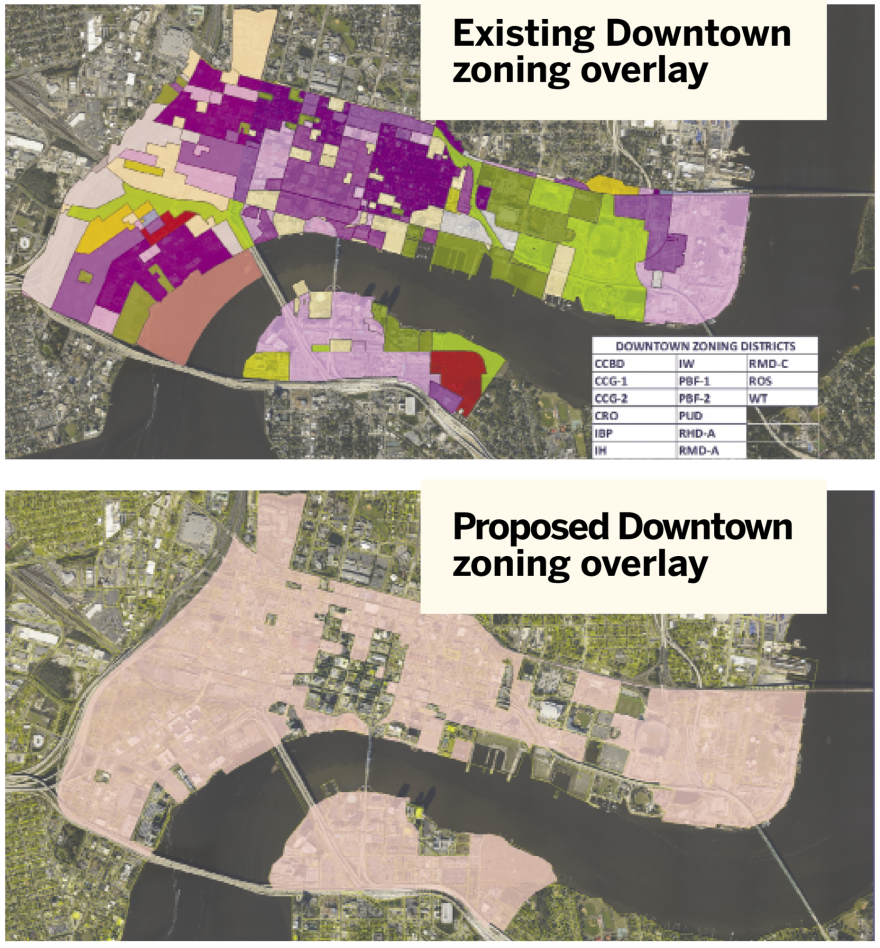Pending City Council approval this summer, Downtown Jacksonville will be rezoned as a single category, development design standards will be altered and new Downtown district borders will be drawn.
WJCT News partner the Jacksonville Daily Record reported council member Lori Boyer introduced legislation Tuesday to overhaul design standards to make Downtown more uniform.
Boyer’s council district includes the Downtown Southbank.
“We’re trying to eliminate the randomness and treat Downtown like a downtown with uniform zoning standards and a clear path so developers can design their projects to the standards,” she said.
Boyer’s bills include 2019-197, which will rezone about 980 acres of Northbank and Southbank property from 14 categories to a commercial central business district category.
“Right now, it’s a mess,” she said. “There’s all these individual properties, each with different zoning.”
Boyer said the mix creates unnecessary work for developers.
“Say you want to build up the entire block, but each building has different zoning,” she said. “Now you’ve got to spend months and a lot of money going through council before you even begin your project.”
The CCBD zoning category allows residential, commercial, office, retail, service, auto showrooms, banks, schools, galleries and museums, parking garages, day care, medical clinics and hospitals, marinas, utilities, mixed-use, entertainment with alcohol and other uses.
Properties zoned CCBD and planned unit development will remain that way, said Boyer.
“It won’t matter which block you’re on, there’s going to be uniformity,” she said.

Changing Districts
Another Boyer bill, 2019-196, will change the Downtown design standards.
Downtown is separated into 10 districts based on historical use and other characteristics. Those boundaries would be redrawn.
“We decided to look and see if those districts were appropriate, based on how we see Downtown today and what we want Downtown to be in the future,” said Boyer.
Her bill changes some district names, combines others and revises some boundaries.
The new districts are Brooklyn, LaVilla, Church, Cathedral, Central Core, Southbank, Sports and Entertainment and Working Waterfront.
Gone are the River Park, Riverfront and Institutional districts.
Each district has what Boyer calls “bonus uses” to account for examples like industrial in the Working Waterfront District or single-family homes in LaVilla.
Bonus uses could include manufacturing, single family, industrial, wholesale distribution, laundry facilities, thrift stores, private clubs and filling stations.
The changes are designed to eliminate the need for developers to seek deviations from design standards.
Most groups that bring projects to the Downtown Development Review Board seek deviations for issues such as building height or minimum parking requirements and most are approved.
The DDRB oversees Downtown design standards.
Boyer said when she began crafting the bill, “we listened to what types of deviations were always being sought at DDRB.”
“We thought if they keep asking for the same deviations then maybe it’s time to update the standard,” she said.

Other Changes
Other provisions in 2019-197 remove, and in some cases impose, height restrictions in areas of Downtown; provide clarity for development along the riverfront; eliminate minimum parking requirements; and provide updated standards for the “public realm,” which Boyer said includes sidewalks, pedestrian areas and public space.
Under the new standard, height restrictions would be eliminated for Downtown except in the Cathedral District, limited to no more than 65 feet, and in Brooklyn west of Park Street, capped at 90 feet.
Construction in the LaVilla district would be capped at 75 feet.
There also is a 200-foot buffer from the bank of the St. Johns River that restricts height as development is closer to the river.
For example, a developer would not be able to build permanent structures within 50 feet of the riverbank, but could build up to 45 feet high from within 50 feet to 125 feet of the river. From there to 175 feet away, you could build up to 75 feet tall.
“We think this preserves access to the river and promotes public use,” said Boyer.
Boyer’s third bill, 2019-195, is a text amendment to the city’s 2030 Comprehensive Plan to allow for the elimination of minimum parking requirements in Downtown.
The state Growth Management Act requires all of Florida’s counties and municipalities to adopt Local Government Comprehensive Plans to guide growth and development. Any change to the plan requires approval from the state Office of Economic Opportunity.
“I expect there will be parking needs in the future, but I think it’s best to let the market dictate that demand rather than us impose that requirement,” said Boyer.
She said the need is not as great as it once was, “and if we’re trying to make Downtown more pedestrian-friendly, then that may include less traffic in some areas.”
Boyer met this week with the DDRB to gain its approval, and she is meeting with the Downtown Investment Authority and Planning Commission next week.
Boyer said she hopes the bills to pass before the new council takes office July 1.




